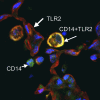Innate immunity in the lungs
- PMID: 16322590
- PMCID: PMC2713330
- DOI: 10.1513/pats.200508-090JS
Innate immunity in the lungs
Abstract
Innate immunity is a primordial system that has a primary role in lung antimicrobial defenses. Recent advances in understanding the recognition systems by which cells of the innate immune system recognize and respond to microbial products have revolutionized the understanding of host defenses in the lungs and other tissues. The innate immune system includes lung leukocytes and also epithelial cells lining the alveolar surface and the conducting airways. The innate immune system drives adaptive immunity in the lungs and has important interactions with other systems, including apoptosis pathways and signaling pathways induced by mechanical stretch. Human diversity in innate immune responses could explain some of the variability seen in the responses of patients to bacterial, fungal, and viral infections in the lungs. New strategies to modify innate immune responses could be useful in limiting the adverse consequences of some inflammatory reactions in the lungs.
Figures





References
-
- Beutler B. Innate immunity: an overview. Mol Immunol 2004;40:845–859. - PubMed
-
- Silverstein AM. History of immunology: cellular versus humoral immunity: determinants and consequences of an epic 19th century battle. Cell Immunol 1979;42:208–221. - PubMed
-
- Guo RF, Ward PA. Role of C5a in inflammatory responses. Annu Rev Immunol 2005;23:821–852. - PubMed
-
- Super M, Thiel S, Lu J, Levinsky RJ, Turner MW. Association of low levels of mannan-binding protein with a common defect of opsonisation. Lancet 1989;2:1236–1239. - PubMed
-
- Schumann RR, Leong SR, Flaggs GW, Gray PW, Wright SD, Mathison JC, Tobias PS, Ulevitch RJ. Structure and function of lipopolysaccharide binding protein. Science 1990;249:1429–1431. - PubMed
Publication types
MeSH terms
Substances
Grants and funding
LinkOut - more resources
Full Text Sources
Other Literature Sources
